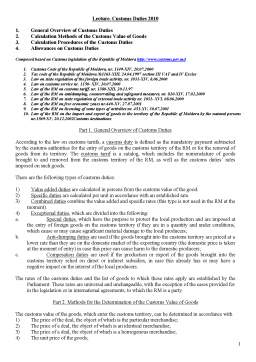Cuprins
- 1. General Overview of Customs Duties
- 2. Calculation Methods of the Customs Value of Goods
- 3. Calculation Procedures of the Customs Duties
- 4. Allowances on Customs Duties
Extras din curs
Part 1. General Overview of Customs Duties
According to the law on customs tarrifs, a cusoms duty is defined as the mandatory payment subtracted by the customs authorities for the entry of goods on the customs territory of the RM or for the removal of goods from its territory. The customs tarrif is a catalog, which includes the nomenclature of goods brought to and removed from the customs territory of the RM, as well as the customs duties’ rates imposed on such goods.
There are the following types of customs duties:
1) Value added duties are calculated in percens from the customs value of the good.
2) Specific duties are calculated per unit in accordance with an established rate.
3) Combined duties combine the value added and specific rates (this type is not used in the RM at the moment).
4) Exceptional duties, which are divided into the following:
a. Special duties, which have the purpose to protect the local production and are imposed at the entry of foreign goods on the customs territory if they are in a quantity and under conditions, which cause or may cause significant material damage to the local producers;
b. Anti-dumping duties are used if the goods brought into the customs territory are priced at a lower rate than they are on the domestic market of the exporting country (the domestic price is taken at the moment of entry) in case this price can cause harm to the domestic producers;
c. Compesation duties are used if the production or export of the goods brought into the customs territory relied on direct or indirect subsidies, in case this already has or may have a negative impact on the interest of the local producers.
The rates of the customs duties and the list of goods to which these rates apply are established by the Parliament. These rates are universal and unchangeable, with the exception of the cases provided for in the legislation or in international agreements, to which the RM is a party.
Part 2. Methods for the Determination of the Customs Value of Goods
The customs value of the goods, which enter the customs territory, can be determined in accordance with
1) The price of the deal, the object of which is the particular merchandise;
2) The price of a deal, the object of which is an identical merchandise;
3) The price of a deal, the object of which is a homogenous merchandise;
4) The unit price of the goods;
5) The estimated value of the merchandise;
6) The reserve method
Usually, the determination of the customs value of the goods is done in accordance with the price of the deal, the object of which is the particular merchandise. If this method cannot be used, other methods apply. In this case, each consecutive method is used if the previous method could not be applied.
Each method for determining the customs value of the merchandise has its specific features. For example, when applying the first method, the price of the deal includes the following components:
1. Expenses for the delivery of the merchandise to the airport or another place of entry of the merchandise on the customs territory;
2. Insurance costs;
3. Transportation costs;
4. Loading costs;
5. Unloading and transfer costs;
6. Commission fees;
7. Brokerage fees;
8. Container, package and packaging costs;
9. Licence and other payments for the utilization of intellectual property rights.
Part 3. Calculation Procedures of Customs Duties
1) In addition to customs duties, which are calculated according to the value of the merchandise and the rate stipulated in the customs tarrif, the customs authorities retain charges for the execution of customs procedures.
The following fees are paid when goods move across the customs frontier and in other cases as set forth by the legislation:
customs duty -in conformity with the import customs tariff
value added tax - in conformity with Chapter III of the Fiscal Code
excise taxes - in conformity with Chapter IV of the Fiscal Code
customs service fees - in conformity with the Law on customs tariff
other fees as set forth by law.
The import duties and export duties are paid directly by the declarant, customs broker or another person as foreseen by law.
The import duties and export duties are paid in advance, prior to the customs declaration submission. At the moment of goods clearance, the only accepted payment is that of the difference between the calculated sum and the amount paid in advance.
Natural persons who are not entrepreneurs shall pay the import or export duties at the moment of border crossing, with the exception of the import or export duties that are to be paid at the clearance of the unattended luggage and means of transportation.
Preview document
Conținut arhivă zip
- Custom Duties.doc





















